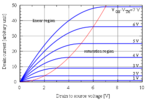Follow along with the video below to see how to install our site as a web app on your home screen.
Note: This feature may not be available in some browsers.
No, it only ensures that you will be at the border between
linear and saturation. The inversion "strength" depends on
the current being thrown at it.
There's not much "advantage" to weak inversion, it is just
where you end up when trying to do low power analog.
Or operate at low voltages (for reasons of chasing low
power, usually).
For FETs that are not tied D-G, some DC attributes
improve at lower Vgs (like Rout / gDS) and some get
worse (like gm) when you operate lower than VT0.
And things like AC bandwidth suffer quite a bit.

look at the transistor curve, the different levels of current is controlled by VGS-Vth. View attachment 140825